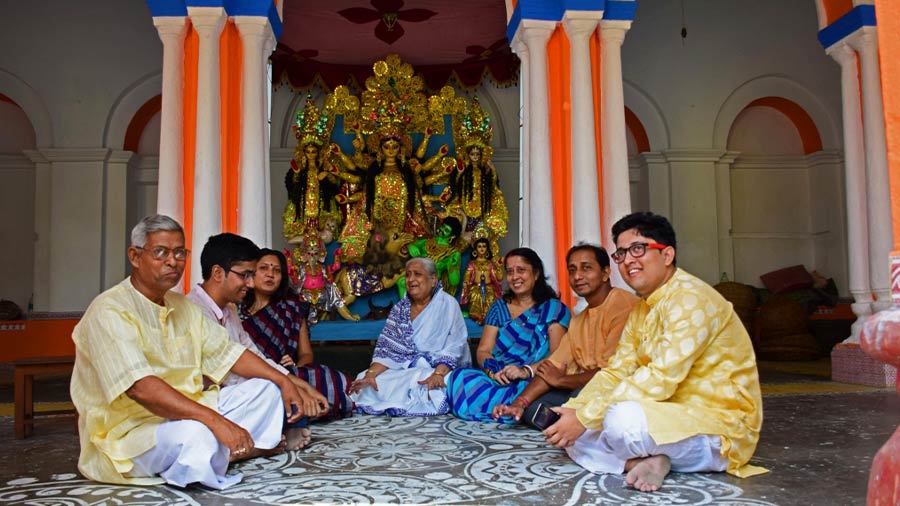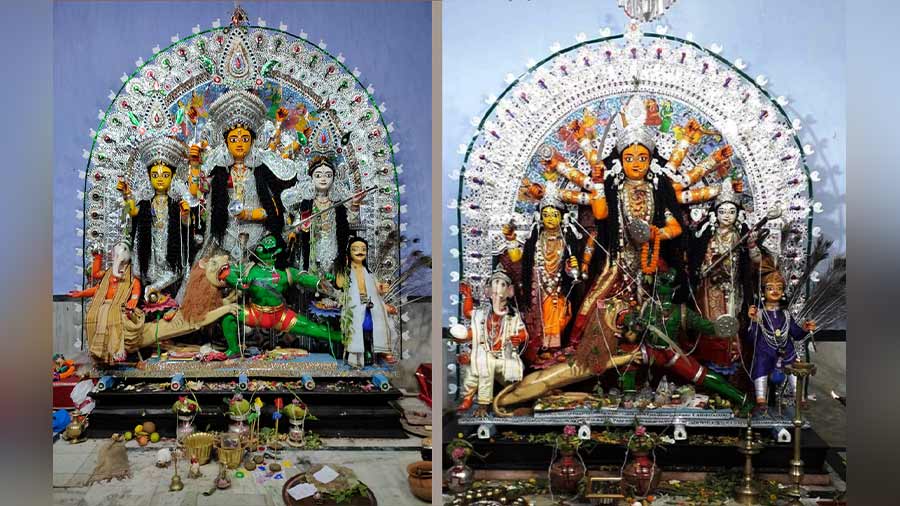The sound of a single gunshot being fired is how residents of Kalyanpur adjacent to Baruipur in South 24-Parganas know it’s time for sandhi pujo. The ritual has been continuing in the Bandyopadhyay family puja for more than two centuries.
The puja was started by zamindar Sahashraram Bandyopadhyay who the family claims came from Mahishadal in West Midnapore.
The five-arched Durga dalan and the adjoining temple of Narayan and Lakshmi were built by him as well. A plaque on the Durga dalan says that the puja started in the Durga dalan in the Bengali year 1157 (AD 1750).
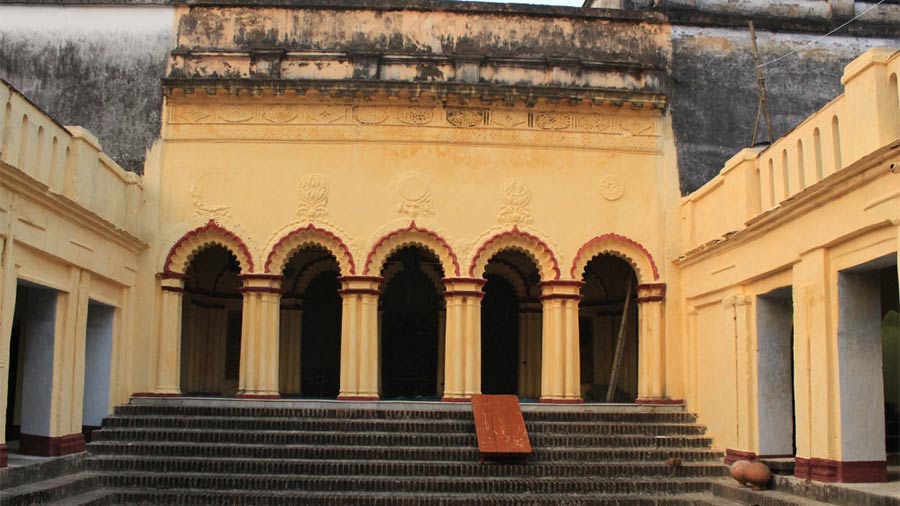
The Durga ‘dalan’ of Bandopadhyay family was built by zamindar Sahashraram Bandopadhyay in 1750 Debojit Chattopadhyay
The Bandyopadhyay barir pujo follows the Kalikapuran. Bhaskar Bandopadhyay of the family said recitation of verses of Chandi, a Hindu religious text describing the victory of goddess Durga over the demon Mahishasura, starts on Pratipod tithi and continues till Navami. The verses are repeated over a period of nine days. The ghot is installed on Pratipod itself. The Durga dalan and its adjoining area are cleaned and prepared for the puja by a group of people who come from Nabagram near Bakkhali.
From protipod till Lakshmi Puja, the family members do not consume meat, egg, onion or garlic. Out of the non-vegetarian food, only fish is consumed. However, sacrificial meat is consumed as an exception, cooked without onion and garlic.
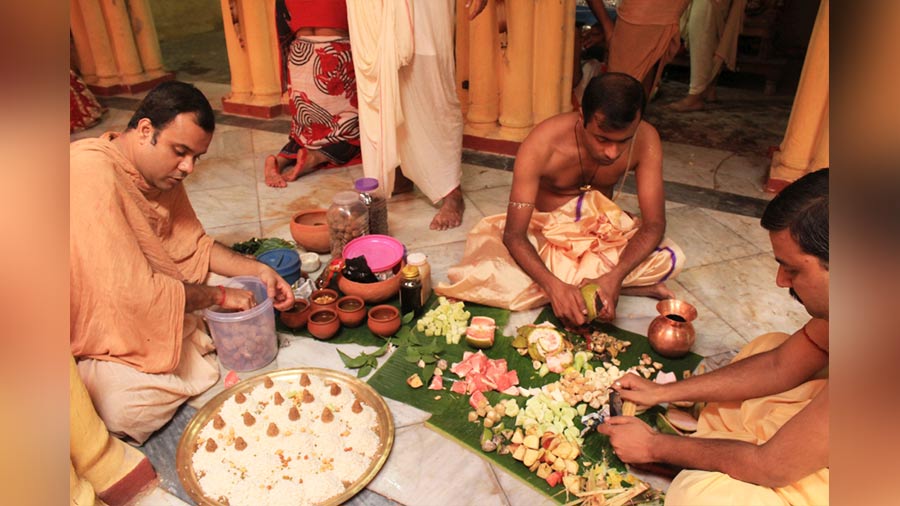
The menfolk of the Bandopadhyay family carry out all arrangements of Durga Puja, starting from cutting the fruits and arranging the offerings Debojit Chattopadhyay
Bodhon starts on Sashthi at a dedicated spot under a bel (woodapple) tree fenced by darma (a mat made of bamboo slips) just outside the Bandyopadhyay premises.
Keeping the age-old tradition alive, the male members of the family solely do all arrangements of Durga Puja, starting from cutting the fruits to arranging the offerings. Only those women who have been initiated religiously by their guru are allowed to cook offerings for the goddess.
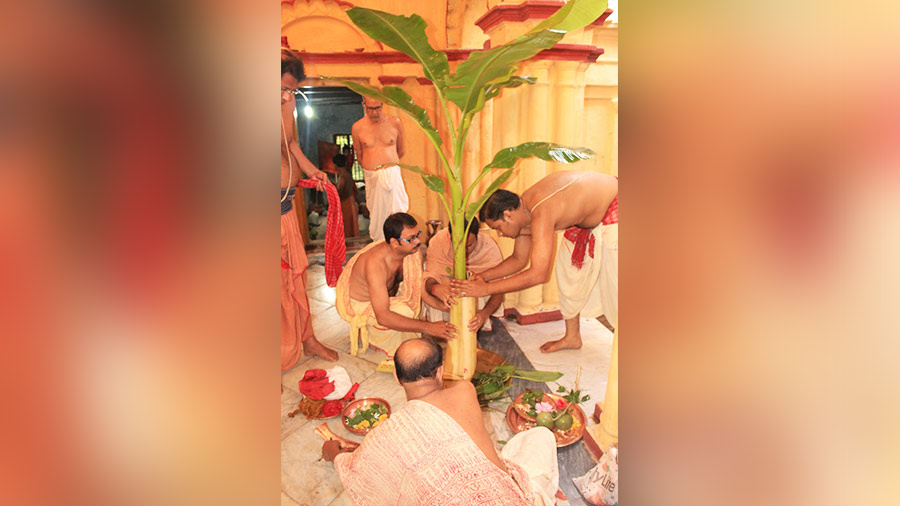
The ‘nabapatrika’ rituals are a strictly indoor affair and are conducted on Durga ‘dalan’ Debojit Chattopadhyay
The nabapatrika rituals are a strictly indoor affair and are conducted on the Durga dalan. The family deities Narayan and Lakshmi are installed beside goddess Durga during Durga Puja and are only taken away during animal sacrifice. There are four instances of sacrificing a goat during Durga Puja in the Bandopadadhyay family home — on Saptami, Ashtami, during Sandhi Puja and on Navami. On Navami, along with goat sacrifice, food grains are also sacrificed.

The mahasnan or royal bath of the goddess takes place on Ashtami, Sandhi Puja and Navami. A silver mirror is kept at the feet of the goddess and the reflection is bathed with ingredients kept in 21 silver small cups. Avik Bandopadhyay from the family said the ingredients include tepid and normal water of Ganga, milk, curd, honey, sugar, extract of curd, several flowers, agaru perfume and an extract known as ‘sarba ousadhi maha ousadahi’, which is a combination of dust of several herbs. He also said that after each mahasnan, the goddess is adorned with garlands of several flowers such as hibiscus, shiuli, lotus and aparajita.

The ingredients of ‘mahasnan’ or royal bath is kept in 21 silver small cups Debojit Chattopadhyay
A special garland is made out of leaves of amloki or amla tree is included in this. From Saptami to Navami, after the end of puja and animal sacrifice rituals, there is a ritual of mash bhakta boli conducted at the Bandyopadhyay home. Avik Bandyopadhyay said a substantial quantity of aatop rice grains, ghee, honey and mashkalai dal (considered to be non-vegetarian food) are mixed inside a dhuchuni (a perforated vessel made of thinly cut bamboo for washing rice). Then 108 plus 10 plus 1 portions are placed on a banana leaf in front of the goddess.
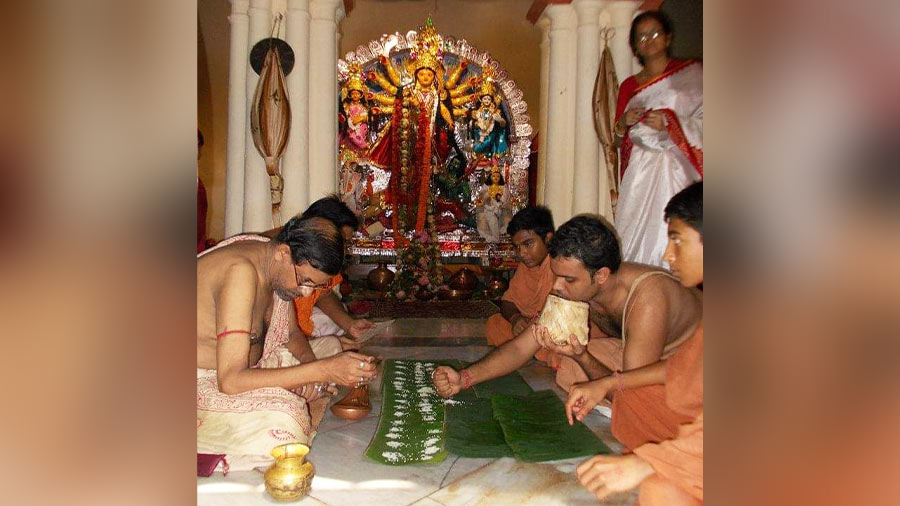
The ritual of ‘maash bhakta boli’ conducted at Bandopadhyay residence Debojit Chattopadhyay
Ninety-four-year-old Kalyan Bandopdhyay explained how 108 small portions are dedicated to female spirits like Dakini and Jogini. The next 10 big portions are dedicated to lokpals of Hindu Dharma (Kuber, Yama, Indra and Varun) and various stars and planets and the final bigger portion is dedicated to the goddess Durga herself. Each portion is mashed by hand and dedicated to the above-mentioned entities.
Shrabani Bandyopadhyay from the family gave a detailed description of bhog offered to the goddess. On the mornings of Saptami, Ashtami and Navami, the goddess is offered a khichuri of gobindabhog rice and moong dal with coconut, herbs, potato, brinjal, pumpkin or pointed gourd fries along with fried fish. An interesting fact to note here is that since Narayan resides besides goddess Durga in the thakur dalan, the fried fish and other fish dishes are kept at a distance.

Sandhi Puja at the Durga ‘dalan’ of Bandopadhyay family Bhaskar Banerjee
On Saptami, just after noon, the bhog served includes atap rice, arhar dal, five types of fried vegetables, vegetable curry made of pointed gourd, potato and grams, fish curry, sacrificial meat curry, chutney (sweet sauce) made with local jalpai (Olive), payesh (sweet dish made of rice, milk and sugar) with puli pithe soaked in payesh, fried puli pithe filled with fried moong dal and sweet curd.
On Ashtami, the noon time bhog is the same except that the vegetable curry is made of potato and cauliflower and chutney (sweet sauce) made of amsatwa (mango pulp). On Navami, the menu remains the same except that moong dal is provided and the vegetable curry is made of raw jackfruit. On Dashami, panta bhaat (pre-cooked rice), kochur shak and jalpai chutney is offered to the goddess.
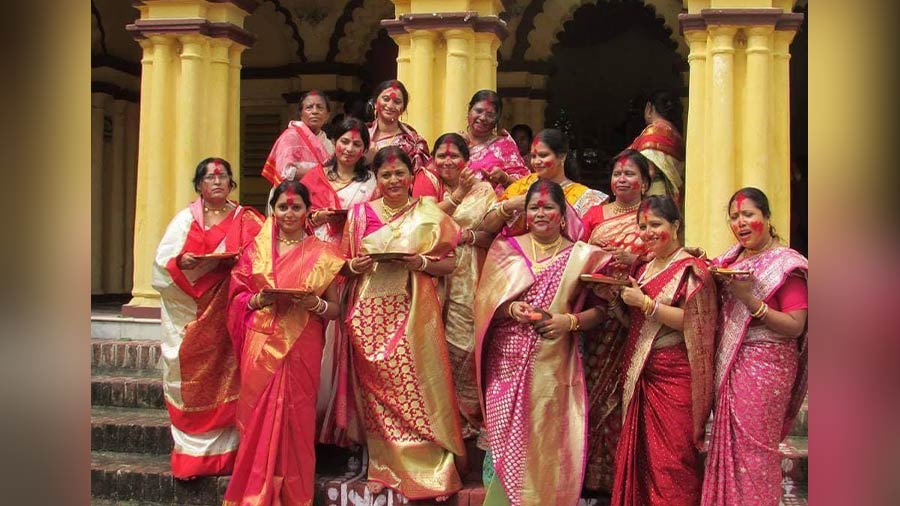
Ladies of the Bandopadhyay family after ‘sindur khela’ on Dashami Bhaskar Banerjee
In the afternoon, the goddess is offered luchi made without salt and white narkel naru (coconut sweet) on all three days. The red narkel naru is offered to the goddess with different kinds of naibadya (offering).
Shrabani elaborated that in case on any of the three days, there is not enough time to cook the sacrificial meat to be served during the designated time of the bhog, the raw meat is offered immediately after the sacrifice along with red narkel naru and banana.
On Dashami, the Beranjali rituals are followed at the Bandyopadhyay residence, whence the family members go in circumambulation around the goddess chanting the pushpanjali mantra. The sindur khela ritual of the Baruipur Bandyopadhyay family is the talk of the town. After the womenfolk have completed the rituals of baran in the afternoon, the deity is carried on shoulder by men and they complete the process of immersion at the nearby Adi Ganga.
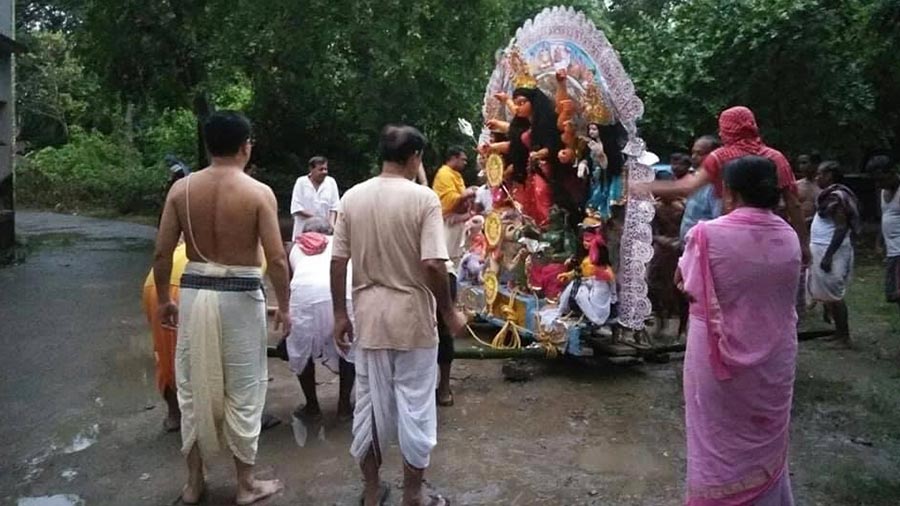
The deity is carried on shoulder by men and they complete the process of immersion at the nearby Adi Ganga Bhaskar Banerjee

